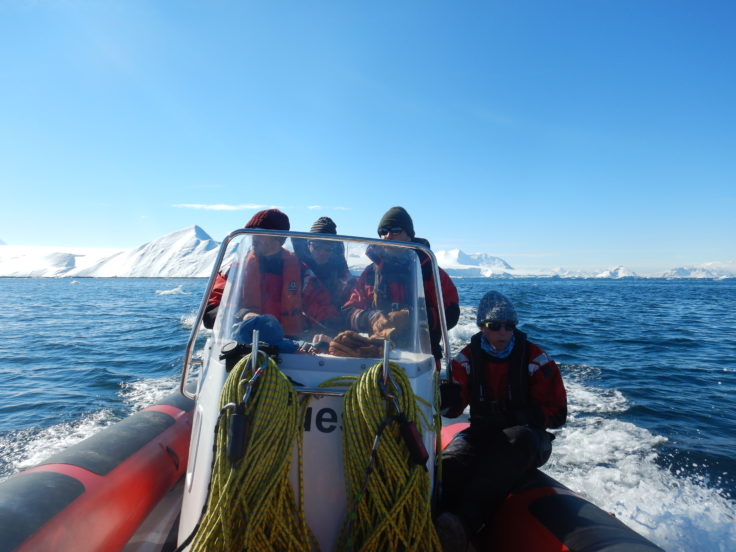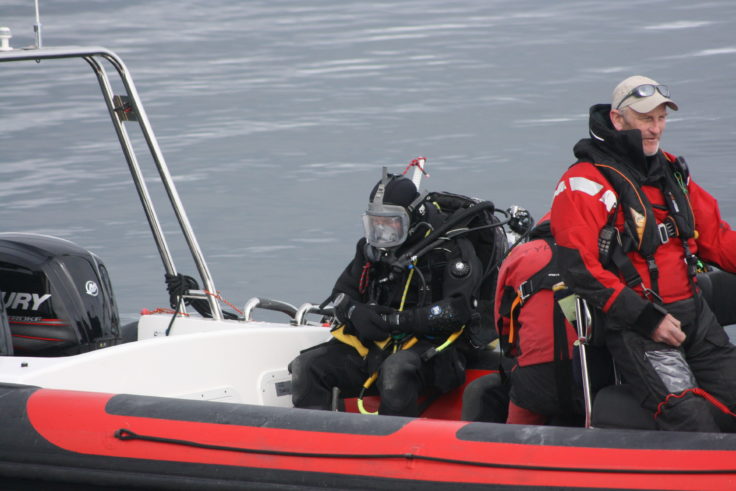Blog: The Rothera marine team
8 February, 2021 Rothera
Nadia Frontier is the new Marine Biologist at Rothera Research Station. In her latest blog, Nadia takes us through safety training, wildlife sightings, and what it takes to dive successfully in Antarctica.
Within days of arriving on station, we were out on the boat with the Rothera marine team to witness our first Antarctic dive. It was fantastic to see the operation unfold from kitting up and filling hot water bottles (to keep out neoprene hood and gloves nice and toasty) to craning the boat onto the wharf and weaving through ice! It was a dream come true. Having been above sea level for 7 weeks on the deck of the JCR, witnessing the Antarctic environment at sea level made the icebergs feel even more impressive.
Unfortunately, just as the divers were preparing to enter the water, I spotted an enormous dorsal fin meters from the boat! “Orca” I cried as a group of eight individuals emerged including two calves. I was desperately excited to see orca up close but I had to contain my excitement because the presence of orca means that a dive must be cancelled. Unless the orca are seen again, under BAS regulations, divers cannot enter the water for 4 hours following the sighting. The same rules apply for leopard seals, although these predators do not actively hunt humans, they could pose a risk to divers. Seeing these animals before a dive is understandably taken very seriously.
The marine team training has been very varied. It has included using a tractor to move the boat between the boat shed and the wharf – as well as learning how to ‘banks’ (give appropriate hand signals), manoeuvre trailers, operate the controls and drive the tractor, which have been crucial first steps. Furthermore, our lorry loader training course that we did back in the UK has set us up for operating the crane and lowering Quest: a 2 tonne boat from the wharf into the water.

Our bursts of training have set us up well for when we replace the current marine team in March 2021. There is a lot to take in and, like always, a large part of learning happens on the job. Our first dives have been incredible and the cold has not been as bad as I had expected. However, we are still in summer where the sea temperature is in positive degrees; (we recorded 0.18°C at 15m during our last water sampling event) diving in -1.8°C in winter may be another kettle of fish. The diving process is becoming increasingly slick as we kit up in our thermal layers and drysuit, put the boat on the water, reach the dive site, have the diving offer clip our life lines to us (including a communication line which is woven into them), don our hood, mittens and diving accessories and conduct the final comms check with our full face mask strapped to our face before rolling backwards into the sea.

I am constantly thinking about my friends and family back home experiencing the relentless threat of Covid-19. Wishing you all the best and sending hugs.
I’ll be blogging throughout my time at Rothera at https://nadiafrontier.blogspot.com/
–
Further information
Science at Rothera Research Station: https://www.bas.ac.uk/polar-operations/sites-and-facilities/facility/rothera/#science
Bonner Laboratory and dive facility: https://www.bas.ac.uk/polar-operations/sites-and-facilities/facility/rothera/bonner-laboratory-and-dive/